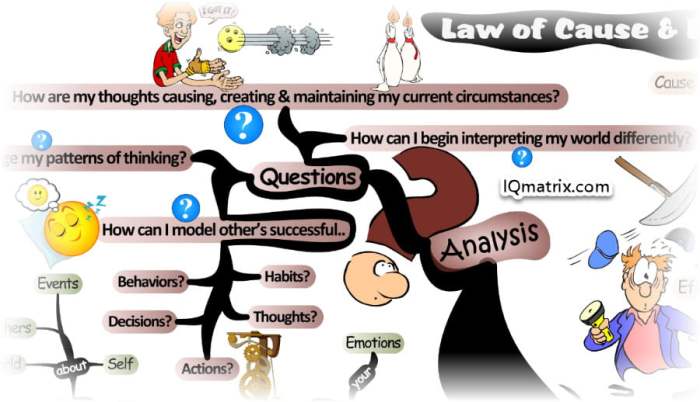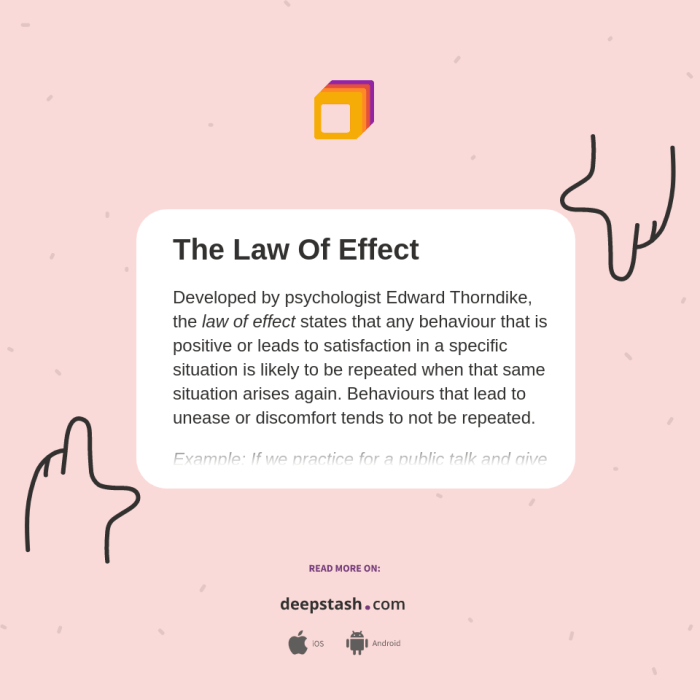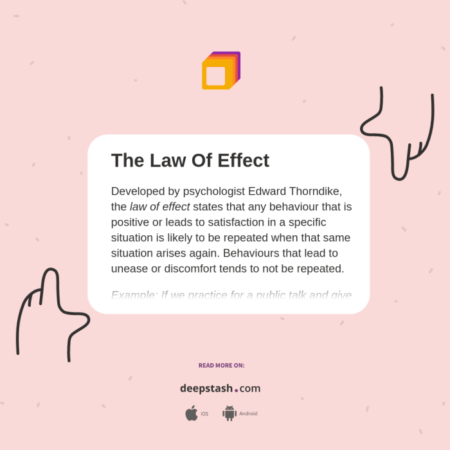
Who is commonly attributed for discovering the law of effect? The answer is Edward Thorndike, a pioneering psychologist whose groundbreaking research on animal learning revolutionized our understanding of behavior. Thorndike’s experiments, particularly those involving cats in puzzle boxes, led him to formulate the Law of Effect, a fundamental principle in psychology that states behaviors followed by satisfying consequences are more likely to be repeated, while those followed by unpleasant consequences are less likely to occur.
Thorndike’s work laid the foundation for behaviorism, a school of thought that emphasizes the role of environmental factors in shaping behavior. His research, combined with the contributions of other researchers like Ivan Pavlov, paved the way for the development of effective behavioral therapies, educational strategies, and training methods.
Edward Thorndike and the Law of Effect

Edward Thorndike, a pioneering psychologist, is renowned for his groundbreaking work on animal learning and the formulation of the Law of Effect. Through his meticulous experiments, Thorndike laid the foundation for understanding how behaviors are shaped by their consequences, a principle that has had a profound impact on fields ranging from education to behavioral therapy.
Thorndike’s Experiments with Cats
Thorndike’s research involved placing cats in puzzle boxes, which were enclosed spaces with a simple mechanism for escape, such as a latch or a lever. The cats, initially unfamiliar with the box, would exhibit various behaviors in their attempts to escape, such as scratching, clawing, and pushing. Thorndike observed that over time, the cats would gradually learn to manipulate the mechanism that allowed them to escape.
“The Law of Effect is the principle that behaviors followed by favorable consequences become more likely, while behaviors followed by unfavorable consequences become less likely.”
These experiments were instrumental in revealing the fundamental principle that behaviors are influenced by their consequences. The cats, through trial and error, discovered that certain actions led to a rewarding outcome—escape from the box—while others did not. This observation led Thorndike to formulate the Law of Effect.
The Core Principles of the Law of Effect
The Law of Effect states that behaviors followed by favorable consequences become more likely to be repeated, while behaviors followed by unfavorable consequences become less likely to be repeated. This principle is based on the idea that organisms learn through association, linking their actions with the consequences they produce.
- Reinforcement: A consequence that increases the likelihood of a behavior being repeated is known as reinforcement. This can be either positive reinforcement, where a pleasant stimulus is added, or negative reinforcement, where an unpleasant stimulus is removed.
- Punishment: A consequence that decreases the likelihood of a behavior being repeated is known as punishment. This can be either positive punishment, where an unpleasant stimulus is added, or negative punishment, where a pleasant stimulus is removed.
Applications of the Law of Effect
The Law of Effect has broad applications in various settings, demonstrating its enduring relevance in understanding and shaping behavior.
Education
In education, the Law of Effect is a cornerstone of effective teaching methods. Teachers utilize reinforcement strategies, such as praise, rewards, and positive feedback, to encourage desired behaviors and academic performance. Conversely, negative consequences, such as detentions or low grades, are used to discourage undesirable behaviors.
Animal Training
Animal trainers extensively rely on the Law of Effect to train animals for various purposes, from performing tricks to assisting individuals with disabilities. Trainers employ positive reinforcement techniques, such as treats or praise, to reward desired behaviors and shape the animal’s responses.
Behavioral Therapy
Behavioral therapists utilize the Law of Effect in treating various psychological conditions, including anxiety disorders, phobias, and substance abuse. By identifying and modifying maladaptive behaviors, therapists aim to replace them with more functional and adaptive behaviors.
Early Contributions to the Law of Effect: Who Is Commonly Attributed For Discovering The Law Of Effect

Thorndike’s groundbreaking work on the Law of Effect built upon a rich history of philosophical and psychological thought. While Thorndike is credited with formalizing the law, his work was influenced by earlier thinkers who explored the concept of associationism and the role of consequences in learning.
Associationism and the Role of Consequences
The roots of the Law of Effect can be traced back to associationism, a philosophical concept that posits that learning occurs through the association of ideas or events. Early associationists, such as Aristotle, proposed that learning occurs through repeated pairings of stimuli and responses. This idea was further developed by philosophers like John Locke and David Hume, who argued that the mind is a blank slate at birth and that all knowledge is acquired through experience.
These early thinkers recognized the importance of consequences in shaping learning. Aristotle, for instance, observed that repeated pairings of stimuli and responses could lead to stronger associations. He also noted that the timing of these pairings influenced the strength of the association. These ideas were further elaborated by later philosophers, who recognized that consequences could either strengthen or weaken associations.
Ivan Pavlov and Classical Conditioning
The work of Ivan Pavlov, a Russian physiologist, provided a significant contribution to our understanding of learning and behavior. Pavlov’s research on classical conditioning demonstrated that a neutral stimulus could come to elicit a response through repeated pairings with a stimulus that naturally elicits that response. For example, Pavlov found that dogs could be conditioned to salivate at the sound of a bell if the bell was repeatedly paired with the presentation of food.
Pavlov’s work highlighted the importance of environmental stimuli in shaping behavior. He showed that learning could occur through the association of stimuli, even in the absence of conscious awareness. This research provided further evidence for the role of consequences in learning, as the pairing of the bell with the food resulted in a change in the dog’s behavior.
Comparing Thorndike’s Contributions
While Thorndike’s work was heavily influenced by the ideas of earlier thinkers and researchers like Pavlov, his contributions to the Law of Effect were unique and significant. Thorndike’s focus on the role of consequences in shaping behavior, as well as his emphasis on the importance of reinforcement, provided a more precise and testable framework for understanding learning. His experimental work, particularly his studies with cats in puzzle boxes, provided empirical evidence for the Law of Effect.
Thorndike’s research also differed from Pavlov’s in its focus on voluntary behavior. Pavlov’s work focused on involuntary responses, such as salivation, while Thorndike’s work explored the consequences of voluntary actions, such as pressing a lever or escaping from a box. This distinction is important because it highlights the role of choice and intentionality in learning. Thorndike’s work suggested that learning is not simply a matter of associating stimuli but also involves the individual’s active participation in the learning process.
Impact of the Law of Effect
The Law of Effect, a fundamental principle in learning theory, has had a profound and lasting impact on the development of psychology, particularly in the field of behaviorism. It has also found practical applications in various fields, shaping our understanding of how behavior is learned and modified.
Influence on Behaviorism, Who is commonly attributed for discovering the law of effect
The Law of Effect served as a cornerstone for the development of behaviorism, a school of thought in psychology that emphasizes the study of observable behavior and its relationship to environmental stimuli. Behaviorists, led by figures like John B. Watson and B.F. Skinner, embraced the Law of Effect as a scientific foundation for understanding learning. They argued that behavior is shaped by its consequences, with behaviors followed by positive reinforcement becoming more likely and those followed by punishment becoming less likely. This focus on observable behavior and its environmental determinants revolutionized psychology, shifting the focus away from introspection and mental processes.
Closing Notes

The Law of Effect continues to be a cornerstone of modern psychology, influencing fields like education, marketing, and game design. Its applications are diverse, ranging from designing effective reinforcement strategies in classrooms to creating engaging game mechanics that keep players motivated. While the Law of Effect has its limitations, it remains a powerful tool for understanding and shaping human and animal behavior, and its legacy continues to inspire ongoing research and debate.
FAQ Guide
What were the main findings of Thorndike’s experiments?
Thorndike found that cats learned to escape from puzzle boxes by trial and error. They gradually eliminated ineffective behaviors and repeated successful ones, demonstrating the importance of consequences in learning.
How does the Law of Effect differ from classical conditioning?
Classical conditioning focuses on learning through associations between stimuli, while the Law of Effect emphasizes the role of consequences in shaping voluntary behaviors.
What are some practical applications of the Law of Effect in education?
Teachers can use positive reinforcement, such as praise or rewards, to encourage desired behaviors in students. They can also employ negative reinforcement, such as removing a disliked task, to strengthen positive behaviors.





